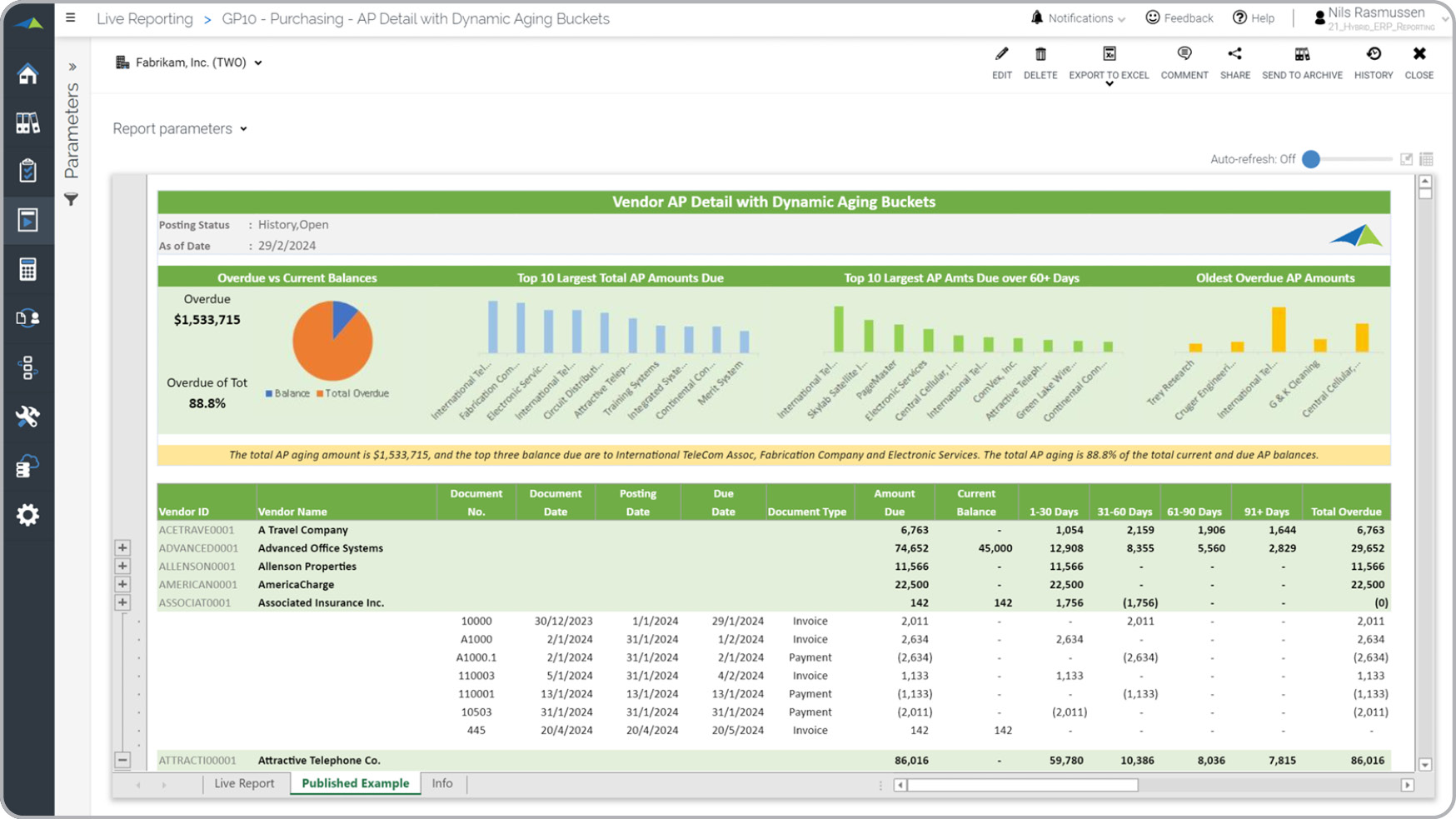Accounts Payable Report with Dynamic Aging and Vendor Analysis
What is
a
Accounts Payable Report with Dynamic Aging and Vendor Analysis
? Payables reports with dynamic aging buckets are considered operational reports and are used by accountants and accounts payable (AP) managers to analyze upcoming and overdue payments to their vendors. Some of the key functionality in this type of dashboard report is that it uses posting dates and due dates from the ERP's vendor transactions to automatically group current and overdue payment balances into aging buckets. The top of the report has 5 distinct analytics sections: 1) KPIs showing overdue amounts and overdue amounts as a percent of total payments, 2) graphical display of the same two metrics, 3) Top 10 largets amounts due, 4) Top 10 largest amounts more than 60 days overdue, 5) Oldest overdue amounts. In addition, the main body of the report shows each vendor with all of their detailed AP transactions as well as sub-totals and a grand total. You find an example of this type of dashboard report below.
Purpose of
AP Aging Reports Companies and organizations use AP Aging Reports to support decisions about who should be paid and when. When used as part of good business practices in a accounting department, a company can improve its liquidity as well as reduce the chances that good vendor relationships go sour due to late payments.
AP Aging Report
Example Here is an example of an Accounts Payables Report with dynamic aging buckets and vendor analysis. [caption id="" align="alignnone" width="1748"]
 Accounts Payable Report with Dynamic Aging and Vendor Analysis[/caption] You can find hundreds of additional examples
here
Who Uses This Type of
Dashboard report
? The typical users of this type of dashboard report are: Controllers, accountants, AP managers, purchasing managers.
Other
Dashboard report
s Often Used in Conjunction with
AP Aging Reports Progressive Accounting departments sometimes use several different AP Aging Reports, along with payables reports, purchase order reports, expense reports, expense dashboards, profit & loss reports, balance sheets , cash flow statements and other management and control tools.
Where Does the Data for Analysis Originate From? The Actual (historical transactions) data typically comes from enterprise resource planning (ERP) systems like: Microsoft Dynamics 365 (D365) Finance, Microsoft Dynamics 365 Business Central (D365 BC), Microsoft Dynamics AX, Microsoft Dynamics NAV, Microsoft Dynamics GP, Microsoft Dynamics SL, Sage Intacct, Sage 100, Sage 300, Sage 500, Sage X3, SAP Business One, SAP ByDesign, Acumatica, Netsuite and others. In analyses where budgets or forecasts are used, the planning data most often originates from in-house Excel spreadsheet models or from professional corporate performance management (CPM/EPM) solutions.
What Tools are Typically used for Reporting, Planning and Dashboards? Examples of business software used with the data and ERPs mentioned above are:
Accounts Payable Report with Dynamic Aging and Vendor Analysis[/caption] You can find hundreds of additional examples
here
Who Uses This Type of
Dashboard report
? The typical users of this type of dashboard report are: Controllers, accountants, AP managers, purchasing managers.
Other
Dashboard report
s Often Used in Conjunction with
AP Aging Reports Progressive Accounting departments sometimes use several different AP Aging Reports, along with payables reports, purchase order reports, expense reports, expense dashboards, profit & loss reports, balance sheets , cash flow statements and other management and control tools.
Where Does the Data for Analysis Originate From? The Actual (historical transactions) data typically comes from enterprise resource planning (ERP) systems like: Microsoft Dynamics 365 (D365) Finance, Microsoft Dynamics 365 Business Central (D365 BC), Microsoft Dynamics AX, Microsoft Dynamics NAV, Microsoft Dynamics GP, Microsoft Dynamics SL, Sage Intacct, Sage 100, Sage 300, Sage 500, Sage X3, SAP Business One, SAP ByDesign, Acumatica, Netsuite and others. In analyses where budgets or forecasts are used, the planning data most often originates from in-house Excel spreadsheet models or from professional corporate performance management (CPM/EPM) solutions.
What Tools are Typically used for Reporting, Planning and Dashboards? Examples of business software used with the data and ERPs mentioned above are:
- Native ERP report writers and query tools
- Spreadsheets (for example Microsoft Excel)
- Corporate Performance Management (CPM) tools (for example Solver)
- Dashboards (for example Microsoft Power BI and Tableau)
Corporate Performance Management (CPM) Cloud Solutions and More Examples
December 6, 2020
TAGS:
Reporting,
Solver,
report writer,
Microsoft,
template,
ap aging,
practice,
Acumatica,
Netsuite,
Finance,
AP,
bucket,
GP,
payable,
Business Central,
excel,
ax,
dynamic,
Dynamics 365,
analysis,
Cloud,
Software,
Tableau,
SAP,
example,
aging report,
best,
Sage,
BC,
D365,
NAV,
Intacct,
payables aging,
ap report,
CPM,
report,
SL,
Management,
dynamics,
Power BI

